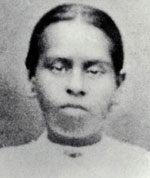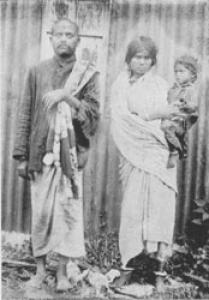Related Collections from the Archive
Related content
Indian women join Gandhi's passive resistance campaign
Before union, at the turn of the century, conditions for Indian families were very restricted. The government curbed Indians' trading rights, confined them to cramped locations and prevented them from acquiring land. Individual merchants and hawkers petitioned and protested against this discrimination but it was only under Mohandas Gandhi, a young Indian lawyer and activist, that resistance became organised. First it was the men who aligned themselves with Gandhi but soon daughters and wives, who had to carry the burden of feeding and raising families under these conditions, also became involved in the passive resistance or Satyagraha Campaign. With Gandhi's help they formed the Indian Women's Association. One of the leading women was Veerammal Naidoo, wife of the militant CK Thambi Naidoo.
Conditions did not improve for Indians after union in (1910) and in 1913 a judgment was handed down in the Supreme Court in Cape Town invalidating all Muslim and Hindu marriages. Gandhi at last allowed the women to join in the Satyagraha Campaign. Their task was to challenge this and other discriminatory measures and licensing laws; the women began to hawk without licences, inviting arrest. Gandhi then recruited volunteers to defy the Immigration Law that prevented Indians from crossing the Transvaal/Natal border without the necessary permits. He and a number of Indians, including women, were arrested and imprisoned for three months. Conditions in prison were abysmal and the women, many of whom had little children with them, suffered greatly. They were released in February 1914. Some relief from oppressive laws was subsequently gained and Hindu and Muslim marriages were eventually given official recognition.
Transvaal Indian Women in the Struggle for Democracy
by Muthal Naidoo
 Valliama R Munuswami: Martyr
Valliama R Munuswami: Martyrand Political Activist of the
Satyagraha Campaign
The Indian women in the Transvaal who became political activists, came from families in the forefront of the democratic movement. They were the wives or daughters of courageous and dedicated leaders. Their husbands and fathers began a tradition and left a legacy of generations of activists to follow in their footsteps.
In the early days, they resisted the Transvaal Governments’ attempts to curb their ability to trade, confine them to tiny specific locations, limit their numbers and prevent them from acquiring land. Individual merchants and hawkers had petitioned and protested against restrictions but it was when Mohandas Karamchand Gandhi arrived in the Transvaal that resistance became organised. Men like Ahmed Mohammed Cachalia and Thambi Naidoo gave up family life to work alongside Gandhi. Though wives and children suffered many privations, they understood what their husbands and fathers stood for and were proud of them. Eventually, they too became involved in the political struggle.
It was in 1913, that the first batch of Indian women became actively involved in resistance. They were mostly wives of men who had been imprisoned during the Satyagraha Campaign. These women had had to carry the burden of providing for their families while their husbands were detained. One of these women, Mrs Veerammal Naidoo, wife of the militant CK Thambi Naidoo, was not able to run her husband’s hawking business and look after her many children at the same time and she eventually lost home and business. Many families suffered in similar ways.
Gandhi became aware of the plight of these people and in 1910 set up Tolstoy Farm to give them economic relief as well as to begin the training of his army of Satyagrahis. In the two or three years that they lived on the farm, the families developed strong bonds and a determined spirit of dedication to the cause.
So when in 1913, a judgment was handed down in the Supreme Court in Cape Town invalidating all Muslim and Hindu marriages, Gandhi at last allowed the women to join in the Satyagraha Campaign. Twelve women, who had lived on the farm, eagerly participated in defiance. They were Mrs Veerammal Naidoo, who was pregnant at the time, Mrs N. Pillay, Mrs K Murugasa Pillay, Mrs A Perumal Naidoo, Mrs PK Naidoo, Mrs K. Chinnaswami Pillay, Mrs NS Pillay, Mrs RA Mudalingum, Mrs Bhavani Dayal, Miss Minachi Pillay, Miss Baikum Murugasa Pillay and sixteen year old Valliamma Munusamy Moodaliar. Their initial task was to challenge restrictive licensing laws and they set off for Vereeniging where they hawked without licences. To their great disappointment, they were not arrested.
Gandhi then went to Phoenix in Durban where he had established a settlement along the lines of Tosltoy Farm many years earlier. Here he recruited volunteers to defy the Immigration Law that prevented Indians from crossing the Transvaal/Natal border without permits. His wife, Kasturba Gandhi, Mrs Jayakunvar Manilal Doctor, Mrs Kashi Chhaganlal Gandhi, Mrs Santok Maganlal Gandhi and twelve men undertook the challenge. They were arrested and imprisoned for three months in Pietermaritzburg. When the Transvaal women heard that the Phoenix contingent had been arrested, they too crossed the border into Natal, but again they were not arrested. So they went to the coalmines in Newcastle where they got the mineworkers to strike against the £3 poll tax that had been imposed on all free (ex-indentured) Indians in Natal. In October 1913, when the miners came out on strike, the women were arrested and also sent to the Pietermaritzburg Prison.
Conditions in prison were abysmal and the women, many of whom had little children with them, suffered greatly. They were released in February 1914. Mrs Veerammal Naidoo gave birth to a son, Mithalin, the day after they were released. Sixteen-year old Valliamma Munusamy Mudaliar, who had contracted a fever in prison, died on 22 February. A memorial was subsequently erected in her honour. The women’s efforts had led to the Great March of miners across the Natal/ Transvaal border, sparked off large-scale strikes in the Durban area and forced Smuts to negotiate with Gandhi. The negotiations resulted in the Indian Relief Act of 1914. The £3 poll tax was abolished and Hindu and Muslim marriages were given official recognition.
After the First World War, the Government escalated its efforts to rid the Transvaal of Indians and greater restrictions were placed on trade, occupation and ownership of land. Indian protest was brought to a head when The Asiatics (Land and Trading) Amendment Act (Transvaal), 37/1919 was passed. The SA Indian Congress was formed and protest became a national effort.
